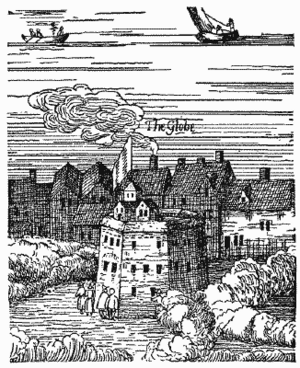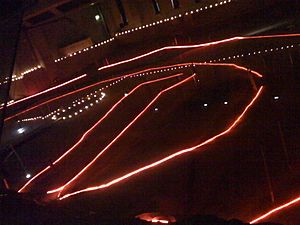The Rose (theatre) facts for kids
The Rose Theatre was a famous theatre from the Elizabethan era in England. It was the fourth public theatre ever built. Before it, there were The Theatre (1576), the Curtain (1577), and the theatre at Newington Butts (around 1580). The Rose was special because it was the first of many theatres built in an area called Bankside, in Southwark. This area was a "liberty," meaning it was outside the control of the main City of London government. In 1989, archaeologists found the remains of the Rose Theatre during an excavation.
Contents
The Rose Theatre's Story
The Rose Theatre was built in 1587 by Philip Henslowe and a grocer named John Cholmley. It was the very first theatre built specifically for plays to ever show a play by William Shakespeare. The theatre was built on land Henslowe rented in 1585. This land was called the "Little Rose" and had rose gardens.
The Rose was the first of many theatres to open in Bankside, which was on the south side of the River Thames. This location was important because it was in an area called the Liberty of the Clink. This meant it was outside the strict rules of the City of London. Henslowe knew that people could easily cross the Thames by boat to see plays there.
A carpenter named John Griggs built the theatre. It was made of wood with a plaster outside and a straw roof. The building had 14 sides and was about 22 meters (72 feet) wide on the outside. The inside space was also 14-sided and about 14 meters (47 feet) wide.
Henslowe kept detailed records of the Rose Theatre. These records are now kept at Dulwich College. The theatre was used by late 1587. In 1592, Edward Alleyn, a famous actor, married Henslowe's step-daughter, and they became business partners.
The years 1592-1594 were tough for London theatres because of a serious outbreak of the bubonic plague. Theatres were closed for almost two years. Many people died, and acting companies had to travel to survive. When the plague ended in 1594, the companies reorganized. The Lord Admiral's Men, led by Alleyn, returned to the Rose. They were very popular, performing hundreds of times a year. They stayed at the Rose for seven years.
Henslowe made the theatre bigger for the Lord Admiral's Men. He moved the stage back by about 2 meters (6.5 feet) to make space for 500 more people. The original Rose was smaller than other theatres. The renovation changed the theatre's shape from a regular 14-sided building to a "distorted egg" or "bulging tulip" shape.
However, the Rose's success led other theatre companies to build nearby. The Swan Playhouse opened in 1596, drawing crowds with comedies and tragedies. In 1599, the Lord Chamberlain's Men built the Globe Theatre nearby. This made things difficult for the Rose.
In 1600, the Privy Council (a group of royal advisors) decided that only two theatres could operate: the Globe Theatre and the Fortune Theatre. Henslowe and Alleyn had already built the Fortune Theatre north of the Thames. The Rose was used for a short time by other acting groups until 1603. Henslowe's lease on the land ended in 1605. The parish wanted to triple the rent, so Henslowe gave up the theatre. The Rose was likely torn down around 1606.
The Rose Theatre was special because it could stage scenes on two levels more easily than other theatres. This meant actors could perform scenes where some characters were high up, like Juliet on her balcony in Romeo and Juliet.
Discovering the Rose: An Amazing Dig
In 1989, during a big building project on Park Street, archaeologists found the remains of the Rose Theatre. This discovery caught the attention of Sam Wanamaker, who was working to rebuild Shakespeare's Globe Theatre.
A group was quickly formed to "Save The Rose Theatre." Many famous actors and volunteers helped protect the site from construction. In March 1989, the theatre's remains were again in danger. A campaign to save the site was launched by famous theatre figures like Dame Peggy Ashcroft and Lord Olivier. A street party was held to raise money and awareness.
Eventually, it was decided to build the new office building *over* the theatre's remains, leaving them safe underneath. This created a very unusual sight in London. A blue plaque at 56 Park Street now marks the spot.
The way the Rose Theatre was handled helped change how archaeology is treated in building projects in the UK. It led to new rules to protect historical sites.
During the excavation, archaeologists found many objects, which are now in the Museum of London. They found lots of fruit seeds and hazelnut shells near the wooden stairs of the theatre. Some people think hazelnuts were like the popcorn of Elizabethan times! These shells, mixed with dirt, made a very tough floor.
The Rose Theatre Today

In 1999, the site of the Rose Theatre was opened to the public. It is located beneath the modern building. Work continues to explore this historic site and protect it for the future. The theatre's foundations are kept covered in a few inches of water to prevent them from cracking. In 2003, the Rose was even used as a performance space for a play called Tamburlaine the Great.
Recreating the Rose Theatre
A copy of The Rose Theatre was used in the film Shakespeare in Love. After being stored for 10 years, it was given to the British Shakespeare Company by Judi Dench. They had plans to rebuild it in northern England, but these plans have not moved forward since 2009.
In 2008, the Rose Theatre, Kingston opened. It is a modern theatre, but its design was inspired by the original Rose Theatre's layout, which was discovered during the 1989 excavation.
See also
 In Spanish: The Rose (teatro) para niños
In Spanish: The Rose (teatro) para niños





